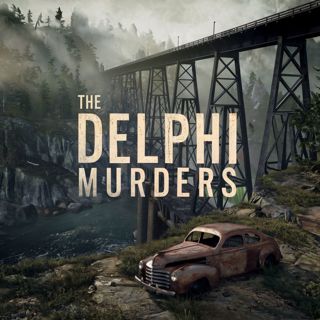
The Delphi Files Exposed — Inside the Incompetent Investigation That IGNORED Red Flags
In this episode, I’m pulling back every layer of the Delphi murders investigation — the layers the public was never supposed to see. The depositions. The affidavits. The early FBI involvement. The abandoned suspects. The suppressed evidence. The symbolic crime-scene elements no one wanted to touch. The Ron Logan raid the state now pretends never happened. The entire fractured internal world that led to one outcome: an investigation that didn’t point to Richard Allen… but collapsed into him. This is not the sanitized version of the Delphi story. This is what happens when leadership breaks down, when agencies contradict each other under oath, when key behavioral assessments vanish from the record, and when major suspects — including the closest neighbor to the crime scene — are aggressively pursued and then quietly erased once they become inconvenient. I walk you through the FBI’s raid on Ron Logan’s home and why the affidavit said there was probable cause he was involved. Why Odinist suspects were ignored. Why symbolic indicators were buried. Why the BAU’s ritual assessment disappeared. Why the bullet had no field documentation. Why investigators contradicted each other about the timeline, about the FBI’s involvement, about who was actually running the case. This isn’t about guilt or innocence. This is about an investigation so fractured, so disorganized, and so unwilling to face its own failures that it needed an answer — any answer — after years of pressure. And that answer became Richard Allen. This is Delphi without the PR spin. And it’s long past time the public saw it. #Delphi #DelphiMurders #TrueCrime #RichardAllen #JusticeSystem #LegalAnalysis #PoliceInvestigation #RonLogan #HiddenKillers #TonyBrueski Want to comment and watch this podcast as a video? Check out our YouTube Channel. https://www.youtube.com/@hiddenkillerspod Instagram https://www.instagram.com/hiddenkillerspod/ Facebook https://www.facebook.com/hiddenkillerspod/ Tik-Tok https://www.tiktok.com/@hiddenkillerspod X Twitter https://x.com/tonybpod Listen Ad-Free On Apple Podcasts Here: https://podcasts.apple.com/us/podcast/true-crime-today-premium-plus-ad-free-advance-episode/id1705422872
24 Nov 16min

Secret Freezer, Midnight Trip: New Clues Point to Dark Plot in Celeste Rivas Case
The case of Celeste Rivas Hernandez has become one of the most shocking true crime stories emerging from Los Angeles, especially as breaking news continues to link disturbing new evidence to music artist D4vd. Celeste, a young woman who had been seen at least once at her home on video, was initially reported missing under confusing circumstances due to her ongoing connection with D4vd, whose music has generated millions of downloads. The investigation shifted dramatically when her dismembered and partially frozen remains were discovered in the front trunk of a Tesla that had been parked near D4vd’s residence before being towed, where a horrific odor triggered the final discovery. Investigators revealed Celeste had been decapitated, her limbs removed and sliced into multiple pieces, her torso intact, and her body sealed in plastic bags. The timeline raises chilling questions, with the vehicle parked on July 29 and Celeste not found until September 8, strongly suggesting she was kept frozen elsewhere for months before being moved. Multiple outlets now confirm that authorities tracked D4vd to a remote area of San Bernardino late at night in the spring, a detail considered highly significant as investigators analyze potential disposal routes. Experts note that California law requires proper reporting and handling of human remains, making desecration a crime even if homicide cannot yet be conclusively proven. A chest freezer seen in the background of D4vd’s social media, still in the box and large enough to hold a body, has fueled growing concerns about long-term storage, freezer burn indicators, and why Celeste was still partially frozen despite sitting in a Tesla trunk during warm Los Angeles weather. Investigators also found farming equipment at a related rental property, raising questions about whether additional steps were planned to destroy evidence but interrupted by the condition of the frozen remains. As law enforcement confirms the involvement of at least one additional suspect, the case has evolved into a grim examination of dismemberment, concealment, forensic timelines, and the expanding circle of individuals tied to Celeste’s disappearance and death. This true crime case continues to deepen as authorities work to uncover the full truth and determine the extent of D4vd’s involvement alongside other suspects. #celesterivas #truecrime #breakingnews #justice #d4vd #losangelescrime #investigation #missingperson #crimenews #forensics Want to comment and watch this podcast as a video? Check out our YouTube Channel. https://www.youtube.com/@hiddenkillerspod Instagram https://www.instagram.com/hiddenkillerspod/ Facebook https://www.facebook.com/hiddenkillerspod/ Tik-Tok https://www.tiktok.com/@hiddenkillerspod X Twitter https://x.com/tonybpod Listen Ad-Free On Apple Podcasts Here: https://podcasts.apple.com/us/podcast/true-crime-today-premium-plus-ad-free-advance-episode/id1705422872
24 Nov 1h 1min

Was Bryan Kohberger's Behavior A Crime At WSU? Ret FBI Robin Dreeke on WSU Law Suit
In tonight’s Hidden Killers Live, we’re unpacking one of the most uncomfortable realities about modern institutions: people show concerning behavior long before they cross a legal line — and institutions rarely know what to do with that space in between. Joining us is retired FBI Special Agent Robin Dreeke, who has spent his career studying that gap. Washington State University found itself exactly in that space. Multiple women reported disturbing interactions. Faculty documented repeated issues. A mandatory meeting was held because of one TA. And yet, without a criminal act, the system froze. This is where human behavior, risk-assessment, civil liberties, and collective avoidance all collide. Robin walks us through the difference between awkward behavior, socially atypical behavior, and genuine threat indicators. We dig into pattern recognition — the difference between one strange moment and a pattern that should raise alarms. We explore why people inside institutions often sense danger before they can justify it, and why ignoring intuition is not only dismissive but dangerous. Stacy joins with insights from The Gift of Fear, explaining why women’s nervous systems often pick up on danger faster than conscious thought. We examine how that instinct was repeatedly ignored at WSU — and why “he’s never been violent” is not proof of safety but a misunderstanding of how violence escalates. Finally, we go deep into the civil liberties paradox. How do you assess risk when the person hasn’t done anything illegal? How do you avoid mistaking neurodivergence for danger? And what should real threat-assessment training look like on a modern college campus? If you want a clearer understanding of what WSU missed — and what every institution should learn from this — this episode is essential. Subscribe for more real-time analysis and expert insight. #HiddenKillers #RobinDreeke #WSU #ThreatAssessment #BryanKohberger #CampusSafety #BehavioralScience #TonyBrueski #CivilLiberties #TrueCrimeAnalysis Want to comment and watch this podcast as a video? Check out our YouTube Channel. https://www.youtube.com/@hiddenkillerspod Instagram https://www.instagram.com/hiddenkillerspod/ Facebook https://www.facebook.com/hiddenkillerspod/ Tik-Tok https://www.tiktok.com/@hiddenkillerspod X Twitter https://x.com/tonybpod Listen Ad-Free On Apple Podcasts Here: https://podcasts.apple.com/us/podcast/true-crime-today-premium-plus-ad-free-advance-episode/id1705422872
24 Nov 25min

Investigators Just Leaked NEW Bombshell Forensic Evidence in D4VD - Celeste Rivas Case
This case just ripped open in a way nobody was prepared for. New reporting from multiple major outlets—citing law-enforcement sources with direct knowledge—now suggests investigators are dealing with something far darker, far more deliberate, and far more coordinated than anyone understood when 15-year-old Celeste Rivas Hernandez was first found inside a Tesla registered to rising music artist D4vd. According to these sources, forensic findings reportedly show indicators consistent with dismemberment and possible freezing or refrigeration before Celeste’s remains were placed in the vehicle. These claims have not been confirmed publicly by LAPD or the medical examiner, but they have been repeatedly reported through investigators speaking privately to outlets like People, NBC4, ABC7, and The Houston Chronicle. And if those reports are accurate, they change everything about how this case is being viewed. Investigators now reportedly believe Celeste may have died months earlier, possibly as far back as spring 2025, based on decomposition indicators described by these sources. Some insiders say this aligns with the possibility that the body may have been stored elsewhere before being transported. And several outlets are reporting that investigators suspect multiple people may have been involved in the concealment process. People Magazine is reporting—again, citing law-enforcement insiders—that the artist has not cooperated with investigators. LAPD has not said that publicly, but if that is what detectives believe privately, it explains the escalation. This episode breaks down everything we now know from these new reports: the forensic bombshells, the rewritten timeline, the multi-suspect angle, the surveillance investigators are analyzing, and what all of this means for where the case goes next. Celeste deserved far better than what happened to her. And now, according to the people closest to this investigation, we’re finally beginning to understand just how dark this story really is. #CelesteRivas #HiddenKillers #TrueCrime #D4vd #CrimeUpdate #Investigation #CrimeNews #ForensicAnalysis #Podcast #JusticeForCeleste Want to comment and watch this podcast as a video? Check out our YouTube Channel. https://www.youtube.com/@hiddenkillerspod Instagram https://www.instagram.com/hiddenkillerspod/ Facebook https://www.facebook.com/hiddenkillerspod/ Tik-Tok https://www.tiktok.com/@hiddenkillerspod X Twitter https://x.com/tonybpod Listen Ad-Free On Apple Podcasts Here: https://podcasts.apple.com/us/podcast/true-crime-today-premium-plus-ad-free-advance-episode/id1705422872
24 Nov 19min

The 13+ Bryan Kohberger Red Flags Nobody Stopped: Inside the WSU Warnings
Before the murders ever happened… long before the headlines, the courtroom footage, and the national spotlight… there was Washington State University. And inside that department, there was a trail. A documented pattern of complaints, warnings, meetings, and uncomfortable conversations all centered around one graduate student: Bryan Kohberger. Tonight on Hidden Killers, we walk through that trail — not with speculation, but with the actual documented behavior that students and faculty reported in real time. The staring. The boundary violations. The gender-based hostility. The “creepy” interactions people whispered about in hallways. The emails students sent with “911” in the subject line. The faculty members who openly worried about his escalating conduct. The office where grad students started keeping a tally board just to track his outbursts. And the mandatory behavioral training the department held, which insiders say was triggered by one person. This episode isn’t about assigning responsibility for the Idaho murders to a university. It’s about the uncomfortable, unavoidable question raised by Kaylee Goncalves’ family: How many red flags does it take before an institution says, “This is not just a behavioral problem — this is a safety problem”? We break down the full timeline of disciplinary actions WSU took, the warnings they issued, and the gradual escalation that eventually led to Kohberger’s removal as a TA — weeks after the murders. We also examine what universities can realistically do, what their limits are, and why so many institutions downplay patterned behavior right up until it becomes catastrophic. This is the conversation no one wants to have, but every victim’s family is forced to confront: when the warning signs were documented, discussed, and recognized… why didn’t they change anything? Join us as we follow the red flags to their uncomfortable conclusion. #HiddenKillers #BryanKohberger #WSU #TrueCrimeNews #IdahoCase #KayleeGoncalves #CrimeAnalysis #LegalDebate #SafetyFailures #TrueCrimeCommunity Want to comment and watch this podcast as a video? Check out our YouTube Channel. https://www.youtube.com/@hiddenkillerspod Instagram https://www.instagram.com/hiddenkillerspod/ Facebook https://www.facebook.com/hiddenkillerspod/ Tik-Tok https://www.tiktok.com/@hiddenkillerspod X Twitter https://x.com/tonybpod Listen Ad-Free On Apple Podcasts Here: https://podcasts.apple.com/us/podcast/true-crime-today-premium-plus-ad-free-advance-episode/id1705422872
24 Nov 23min

Anna Kepner Died on a Cruise — After a Lifetime of Being Failed by Family
Eighteen-year-old Anna Kepner was found dead aboard the Carnival Horizon — concealed under a bed, wrapped in a blanket, partially covered with life vests. But as shocking as those details are, the real story of this case goes far beyond a single cabin on a cruise ship. In this extended deep dive, we unravel the complicated, chaotic, and emotionally explosive family dynamics surrounding Anna — a young woman caught between two deeply fractured households, each carrying years of turmoil long before the tragic events at sea. Anna’s biological mother, Heather, took to TikTok in a raw, unfiltered emotional video, speaking openly about addiction, depression, distance from her children, and her years-long struggle to maintain a relationship with Anna. Meanwhile, Anna’s grandmother and uncle publicly accuse members of the paternal household of withholding the truth. Her ex-boyfriend claims Anna was afraid of a stepsibling. And that stepsibling — a 16-year-old boy — is now described by major outlets as a suspect. The stepmother has invoked her Fifth Amendment rights. Custody filings are unraveling. The family is splintering in real time. And the father at the center of all three marriages remains nearly silent. This is not a simple story. It is not a clean tragedy. It is a case where every branch of Anna’s family tree is cracking under the weight of years of conflict, unresolved trauma, and allegations made publicly by family and friends who say she was never truly safe. Tonight, we look at the family chaos that shaped Anna’s life, the voices now shouting from every side, and the patterns investigators are forced to sift through as they work to uncover what really happened on that cruise ship. This is the full picture — the story behind the story. #HiddenKillers #AnnaKepner #CarnivalCruise #TrueCrime #TonyBrueski #Investigation #FamilyDynamics #FBI #CruiseShipDeath #MaritimeCrime #Stepfamily Want to comment and watch this podcast as a video? Check out our YouTube Channel. https://www.youtube.com/@hiddenkillerspod Instagram https://www.instagram.com/hiddenkillerspod/ Facebook https://www.facebook.com/hiddenkillerspod/ Tik-Tok https://www.tiktok.com/@hiddenkillerspod X Twitter https://x.com/tonybpod Listen Ad-Free On Apple Podcasts Here: https://podcasts.apple.com/us/podcast/true-crime-today-premium-plus-ad-free-advance-episode/id1705422872
24 Nov 19min

Did WSU Miss the Bryan Kohberger Red Flags? Ret FBI Robin Dreeke Explains
Tonight on Hidden Killers Live, we’re cutting straight through the fog that has surrounded Washington State University’s handling of Bryan Kohberger’s behavioral complaints — and we’re doing it with retired FBI Special Agent Robin Dreeke, one of the most respected behavioral experts in the country. This isn’t about blaming people who didn’t have a crystal ball. This is about understanding what behavioral red flags actually are. Before a single crime is committed, before there’s a police report, before anyone can articulate what’s wrong — humans pick up patterns. They feel unsafe. They sense boundary-violating behavior. They feel instincts firing long before the conscious mind can put language to it. And that’s not “overreacting.” It’s evolution. WSU had multiple complaints, private warnings between women, faculty concerns, documentation, meetings, and a mandatory behavioral intervention. Yet the university treated it all like an HR issue instead of a threat-assessment problem. Tonight, Robin breaks down why that distinction matters — and how institutions all over the country make this same mistake. We explore why academia is uniquely vulnerable to minimizing threat indicators, why “but he’s never been violent” is a meaningless metric when evaluating patterned behavior, and why institutions often freeze instead of act. Stacy brings in insights from The Gift of Fear, examining the neuroscience behind the “gut feeling” that so many women reported. And then we tackle the paradox: how do you protect a community when the person at the center hasn’t committed a crime? Where’s the line between rights and risk? And what should universities be trained to recognize that they currently aren’t? This is one of the most important conversations we’ve had — not about predicting crime, but about seeing what institutions are terrified to acknowledge. Subscribe for more deep-dive analysis — only on Hidden Killers. #HiddenKillers #RobinDreeke #WSU #BryanKohberger #BehavioralAnalysis #ThreatAssessment #CampusSafety #TrueCrimeLive #TonyBrueski #RedFlags Want to comment and watch this podcast as a video? Check out our YouTube Channel. https://www.youtube.com/@hiddenkillerspod Instagram https://www.instagram.com/hiddenkillerspod/ Facebook https://www.facebook.com/hiddenkillerspod/ Tik-Tok https://www.tiktok.com/@hiddenkillerspod X Twitter https://x.com/tonybpod Listen Ad-Free On Apple Podcasts Here: https://podcasts.apple.com/us/podcast/true-crime-today-premium-plus-ad-free-advance-episode/id1705422872
24 Nov 24min

Inside Stephen Smith’s Death — Beyond the Murdaugh Rumors
The death of 19-year-old nursing student Stephen Smith has haunted South Carolina for nearly a decade — but with new national attention from the Hulu Murdaugh series, the truth about what happened to him is finally back in the spotlight. In tonight’s Hidden Killers deep-dive, Tony Brueski breaks down the real story behind the case: the strange crime scene, the contradictions in early investigative reports, the forensic inconsistencies that never should’ve been ignored, and the long-buried leads that investigators are only now pursuing. We walk through Stephen’s final night, the discovery of his body on a remote rural road, and the major red flags that made troopers question the hit-and-run narrative from day one. We also address — directly and responsibly — the long-circulating rumors involving the Murdaugh name, explaining what was speculation, what investigators actually found, and why SLED says there is no evidence tying the family to Stephen’s death. More importantly, we highlight the real investigative leads resurfacing today: individuals who made suspicious statements in 2015, inconsistencies in witness accounts, and the newly reclassified finding that Stephen’s death was a homicide, not an accident. With a grand jury working behind the scenes and national pressure mounting, the case is closer to answers than it has ever been. Stephen Smith was more than a rumor in a small Southern county. He was a son, a brother, a friend — a teenager with dreams of becoming a nurse — and someone out there knows exactly what happened to him. If you’re here for real reporting, grounded analysis, and a breakdown that cuts through the noise, you’re in the right place. Subscribe for continuing coverage of the Stephen Smith investigation, Murdaugh updates, and the biggest cases shaping the true-crime world today. #StephenSmith #MurdaughCase #TrueCrime #HiddenKillers #JusticeForStephen #SouthCarolinaCrime #ColdCase #Investigation #TonyBrueski #TrueCrimeCommunity Want to comment and watch this podcast as a video? Check out our YouTube Channel. https://www.youtube.com/@hiddenkillerspod Instagram https://www.instagram.com/hiddenkillerspod/ Facebook https://www.facebook.com/hiddenkillerspod/ Tik-Tok https://www.tiktok.com/@hiddenkillerspod X Twitter https://x.com/tonybpod Listen Ad-Free On Apple Podcasts Here: https://podcasts.apple.com/us/podcast/true-crime-today-premium-plus-ad-free-advance-episode/id1705422872
24 Nov 15min





















